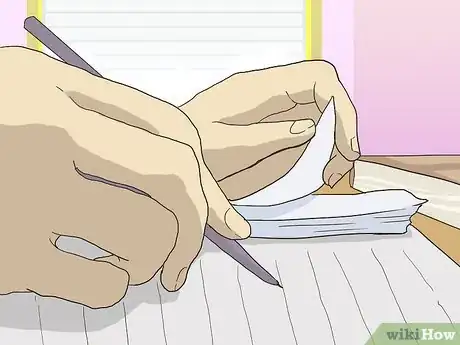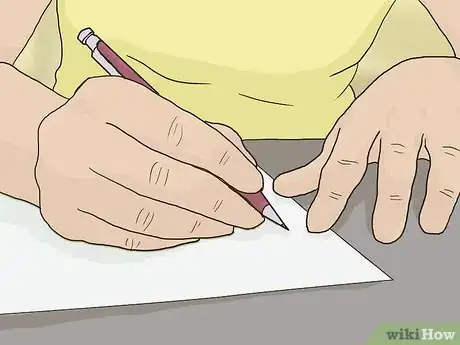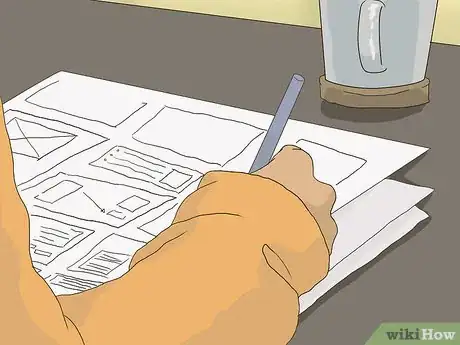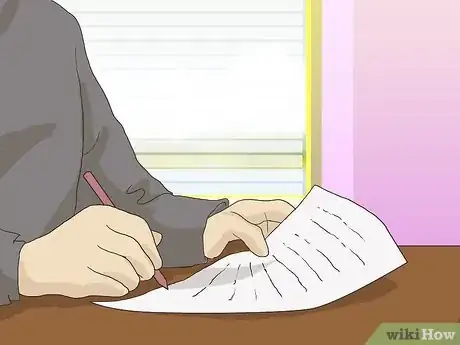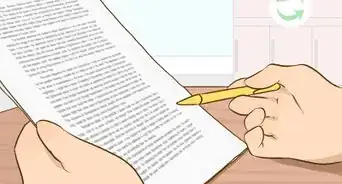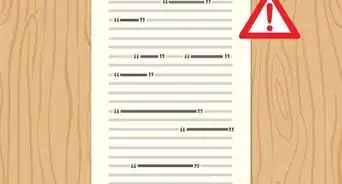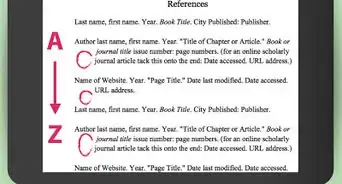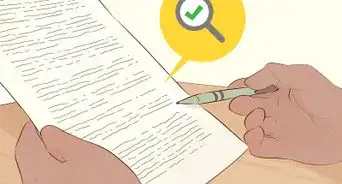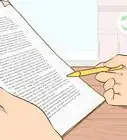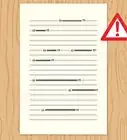wikiHow is a “wiki,” similar to Wikipedia, which means that many of our articles are co-written by multiple authors. To create this article, volunteer authors worked to edit and improve it over time.
There are 10 references cited in this article, which can be found at the bottom of the page.
This article has been viewed 74,204 times.
Learn more...
For a response paper, you must read a text, understand the point of the text, and determine what your own response to that point is. The response paper is more analytical than argumentative. Moreover, even though you need to write about your personal response, that response must be credible and not emotional. Keep reading to learn more about how to go about writing a response paper.
Steps
Understanding the Text
-
1Take thorough notes. Highlighting the text as you read it is not sufficient. You need to take notes on the material, and those notes need to be in your own words.[1]
- Highlighting draws your attention to words and passages you found significant in the text you read, but it does not allow you to record your initial thoughts regarding those passages.
- Take notes on a separate piece of paper. Include paraphrases and quotes taken from the passage as well as your own thoughts about the information you write down.
-
2Develop your understanding of the reading by asking questions. Before you can build your own subjective opinion of the work, you need to understand the work for what it is. A response paper requires you to focus on your own interpretation of the text, but if you want to form a solid opinion, you need to have a basic understanding of the text itself.[2]
- Questions worth asking include:
- What is the main issue that the author or creator is attempting to address?
- What stance does the author take on this issue? What is the author's main claim or point?
- Are there any assumptions the author makes in forming his or her claim? Are these assumptions valid or biased?
- What sort of evidence does the author offer in support of his or her point?
- What points of the argument are strong?
- What points of the argument are weak?
- What are some possible counterarguments to the claims or arguments made by the author?
- What, if anything, makes the main issue or author's main claim important?
Advertisement - Questions worth asking include:
-
3Consider the work within a larger body of works, when appropriate. This step is not always needed, but if you are studying a work within a broader context of works—the works of the author, the works of contemporaries in the same field who address the same topic, and so on—comparing the object of your response to those other works can broaden your understanding of the work and how effective it is.[3]
- Questions worth asking include:
- How does this work relate to others within a collection of works on the same topic, or with regards to another work on a similar topic written by a different author?
- Do the authors of comparable works agree or disagree?
- Do the authors of comparable works address the same part of the same issue or different aspects of it? Do they view the matter being discussed in a similar or different way?
- Does the author who wrote the piece you're responding to have past works that address the same topic? How has that author's views become stronger or weaker in comparison to past works?
- Does the information from one text strengthen or weaken the text you're responding to, and if so, how?
- Questions worth asking include:
Prewriting
-
1Do not drag your feet. The best time to start prewriting for your response paper is immediately after you finish reading the text so that the ideas are still fresh in your mind. If you cannot do any prewriting immediately after, at least do some as soon after as possible.
- Even if you think your ideas would benefit from simmering for a little while before performing a thorough analysis, you should still take the time to write down your initial reaction while it is fresh. In many ways, your initial reaction is the most honest. You can talk yourself into another reaction as time passes, and that other reaction may seem more “intellectual,” but your initial response was your true reaction to the text and should be kept in mind.
-
2Ask yourself about your own reaction. A response paper is centered around your personal, subjective reaction to the text. You may have a general sense about how the text made you feel, but you need to analyze your own feelings regarding the work well enough to understand the underlying thoughts responsible for that feeling.[4]
- Questions worth asking yourself include:
- How does the text relate to you personally, whether in the past, present, or future? How does the text relate to the human experience as a whole?
- Does the text agree or disagree with your worldview and sense of ethics?
- Did the text help you to learn about the topic or understand an opposing view? Were your opinions or previous assumptions challenged or confirmed?
- Does the text directly address topics that you care about or consider important?
- Was the text enjoyable or admirable for its genre? In other words, if the text was fictional, was it enjoyable as entertainment or art? If it was historical, was it admirable from the perspective of a historian? If it was philosophical, was it adequately logical?
- What is your overall reaction? Would you recommend the work to another person?
- As you progress through these questions, write your answers down. In addition to writing down your answers and reactions, also provide evidence from the text to support these answers. Evidence can be in the form of direct quotations and paraphrasing.
- Questions worth asking yourself include:
-
3Determine which reactions are the strongest. While it is true that a response paper is personal and that there is no single “right” response to have, you must do more than simply state what your opinion about a work is. Your opinion must be supported with evidence from the text. Sort through your reactions and thoughts and home in on those that have the most textual support.
- There are multiple brainstorming techniques you can use to help you determine which ideas are strongest. Among these techniques, consider:
- Re-examining your notes
- Recording new ideas as they come
- Using pro/con analysis
- Raising questions about your reactions and using your notes from the text to answer them
- Comparing your reactions directly to your notes and determining which topics have the most overlap
- There are multiple brainstorming techniques you can use to help you determine which ideas are strongest. Among these techniques, consider:
-
4Choose an area of focus or organizing argument. A response paper is not a traditional thesis essay, but you still need to choose an area or argument to focus the majority of the paper around.[5]
- Depending on the requirements of the assignment, you may need to come up with one organizing argument or multiple arguments to discuss. Even when you have multiple points to bring up, however, they should still be somewhat connected to each other.
- A key difference between a traditional thesis and an organizing argument is that a thesis usually exists to prove a point, fact, or thought. An organizing argument demands that the writer analyze the reading in an ongoing manner.[6]
Block Response Format
-
1Write your introduction. You should use your introduction to identify the major themes or ideas of the work and to state your reaction or reactions to these themes.[7]
- For a four to five page paper, your introduction can extend to one or two paragraphs. For a shorter paper, though, restrict it to a short paragraph made up of three to five sentences.
- Introduce the work by describing how the work to which you are responding fits in within the broader topic it addresses.
- You could also introduce the work by explaining your own beliefs or assumptions about the topic the work agrees with before explaining how the work challenges or supports your beliefs.
-
2Summarize the work. Your response paper should not focus on a summary of the work. There is some debate as to the proper length a summary should be for this type of paper, but as a general rule, the summary should only span half of the body paragraphs if not less.[8]
- For a four to five page paper, this section should only take up about two to three paragraphs.
- Describe the content of the work and present the author's main arguments, especially as they affect your response.
- The summary should be somewhat analytical in nature instead of a strict retelling. As you present the details of the author's work and argument, you should use an analytical tone and discuss how well the author managed to get those points across.
-
3Present and discuss your organizing argument. This is the point at which you must explain how you react, on an intellectual level, to the work you are responding to. You can include separate paragraphs explaining where you agree and where you disagree, or you can focus on agreement or disagreement alone, and write out as many paragraphs as needed to cover your response.[9]
- Note that this response format is best to use when you are focusing on a single major theme or argument in a work. It does not work as well if you are discussing multiple ideas presented by a work.
- Back up your analysis with quotes and paraphrases. Make sure that each example is properly cited.
- If you took the time to find textual evidence to support your responses during the prewriting stage, this portion of your paper should be fairly easy. All you really need to do is arrange your argument in a coherent manner and write in the details of the support you have already gathered.
-
4Write your conclusion. At this point, you need to restate your stance to the reader and briefly defend the significance of your stance.[10]
- Even for a four to five page paper, you only need one standard paragraph to accomplish this. For a shorter paper, make this paragraph only three to five sentences long.
- State how this work has a broader effect on you and to the genre or community in which it is a part.
Mixed Response Format
-
1Write an introduction. Create a short paragraph that introduces the major themes and ideas you plan to respond to. Also state or briefly indicate your reaction to these themes.[11]
- Your introduction can span one to two paragraphs for a four to five page paper, but for a short one to two page paper, keep the introduction down to a single short paragraph.
- You can either introduce the work by describing how it fits into the topic it addresses as a whole or by explaining how it impacts your own beliefs on the topic.
- By the end of the introduction, you should have mentioned your "thesis" or organizing argument.
-
2Summarize and agree or disagree with one point. In the mixed response format, you should bring up one issue at a time and respond to each issue as it comes up. Your summary of the theme and how the text represents it should not take up more than one-third of the paragraph, and your response to it should fill up the rest.[12]
- Note that this mixed response format is a better option when you have many loosely connected themes or ideas you want to react to instead of a single overarching one.
- This method allows you to weave your summary and analysis together more naturally and more cohesively. As you bring up a point or example from the text, address your own interpretation of that point directly following your mention of it.
-
3Summarize and agree or disagree with a second point, and so on. When using this format, you should aim to have at least three points to summarize and respond to in single-paragraph form.[13]
- Continue on as you did with your first point. As you summarize a point or argument from the original text, immediately follow it with your own intellectual response to the argument.
-
4Wrap things up with a conclusion. Restate your stance or reactions to the text in a short paragraph. If desired or appropriate, explain why the matter is important overall.[14]
- For a four to five page paper, your conclusion should be a standard size paragraph. For a shorter paper, keep this paragraph down to about three sentences.
- When appropriate, explain how the work has a widespread effect on the genre or community it fits into.
References
- ↑ https://www.indeed.com/career-advice/career-development/how-to-write-a-response-paper
- ↑ https://www.hunter.cuny.edu/rwc/handouts/the-writing-process-1/invention/Writing-a-Response-or-Reaction-Paper
- ↑ https://twp.duke.edu/sites/twp.duke.edu/files/file-attachments/response-paper.original.pdf
- ↑ https://www.hunter.cuny.edu/rwc/handouts/the-writing-process-1/invention/Writing-a-Response-or-Reaction-Paper
- ↑ https://www.awelu.lu.se/genres/student-writing-genres/response-paper/
- ↑ http://faculty.washington.edu/momara/Reader%20Response.pdf
- ↑ https://grammar.yourdictionary.com/writing/how-to-write-a-strong-response-essay.html
- ↑ http://faculty.washington.edu/momara/Reader%20Response.pdf
- ↑ https://writing.colostate.edu/comparchive/rst/resource9.cfm
- ↑ https://www.indeed.com/career-advice/career-development/how-to-write-a-response-paper
- ↑ https://www.indeed.com/career-advice/career-development/how-to-write-a-reaction-paper
- ↑ http://writing.colostate.edu/comparchive/rst/resource9.cfm
- ↑ http://www.hunter.cuny.edu/rwc/handouts/the-writing-process-1/invention/Writing-a-Response-or-Reaction-Paper
- ↑ http://www.hunter.cuny.edu/rwc/handouts/the-writing-process-1/invention/Writing-a-Response-or-Reaction-Paper
Community Q&A
-
QuestionHow do I write a response for a mix of articles?
 Anna Bauer - SLE StudentCommunity AnswerYou can combine quotes that support the topic and say why they are related and how they support the question.
Anna Bauer - SLE StudentCommunity AnswerYou can combine quotes that support the topic and say why they are related and how they support the question.
About This Article
If you need to write a response paper, read through the original texts, and take thorough notes, including paraphrases and quotes as well as your own thoughts. As soon as you finish reading the text, start drafting your ideas, since the thoughts will still be fresh in your mind. Open the paper with an introduction stating the major theme in the work you’re responding to, along with an overview of your reaction to it. Include a section briefly summarizing the original text, then go into detail about whether you agree or disagree with the work. Conclude by restating and defending the significance of your stance. For tips on writing a response to a work with multiple themes, keep reading!






